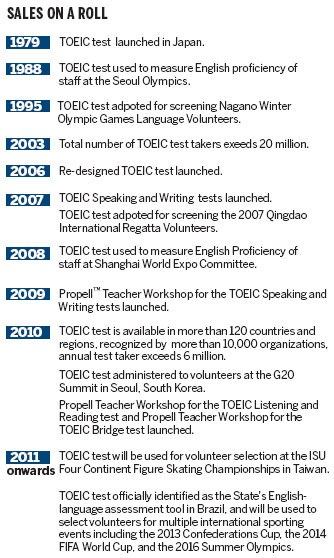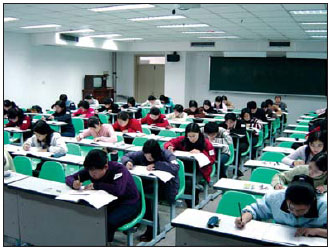News
TOEIC test carves out a large space for itself globally
By Hao Nan (China Daily)
Updated: 2011-01-28 08:04
 |
Large Medium Small |
|
The entrance of ETS headquarters in Princeton, New Jersey. Photos Provided to China Daily |
|
Room full of test takers hard at work on the TOEIC test. |
An increasing number of job hunters, especially those looking for work at a multinational, are also looking at the Test of English for International Communication, or TOEIC test, which was developed to test everyday language skills in the workplace.
It is appearing in job announcements of a number of employers like P&G, LG, Ericsson, Oracle China, Konka, Asus, and Citigroup, who use it as a measure of professional English proficiency.
The test was developed in 1979 by the US' Educational Testing Service (ETS), the creator of the Test of English as Foreign Language (TOEFL) and the Graduate Record Examinations (GRE).
For the past 63 years, ETS has devoted itself to advancing quality and equality in education for people around the world through language assessment based on rigorous research, according to Tan Eng Han, manager of ETS Assessments (Beijing) Ltd.
ETS also conducts education research, analysis and policy studies, Tan said.
The 31-year-old TOEIC test was first tried in Japan and saw rapid growth after that. It has been used by more than 10,000 organizations in 120 countries around the world to screen people for job placement and promotion and to track the learning progress of students, employees, and even executives.
Companies that use the TOEIC test include Eli Lilly, CAMCO, China Southern Airlines, LG Electronics, Motorola Electronics, NEC Logistics, Vietnam Air Navigation Services and the University of Macau.
The test has gradually come to be recognized as a standard to measure English communication ability. It had a sort of triumph when it was introduced to China on Nov 11, 2002 by the Ministry of Human Resources and Social Security's Occupational Skill and Testing Authority (OSTA).
It is not only multinationals that use the test. A large number of Chinese companies and government agencies that want to improve their competitiveness globally have resorted to using the TOEIC test to reach their goals.
Some education institutions like universities and vocational schools have also turned to the test to help their students meet the language requirements of today's global workforce.
"The test consists of exactly what will be used by my students in their everyday work in the future," explained Su Jianhua, a Nankai University English professor.
There were 6 million TOEIC tests given worldwide, in 2010 alone, making it the largest, most widely used English language assessment of its kind.
"The success of the TOEIC tests is evidence of an increased need for English communication skills to compete in a global marketplace," said David Hunt, vice-president and chief operating officer of ETS's Global Division.
"The growing number of test takers and score users is an indication of both the effectiveness of the test, and the growing need for companies to participate in the world economy."
Useful tools
In commenting on the test's significant growth particularly over the past five years, ETS research team members told China Daily that it was "designed as a superior decision-making tool, and can satisfy diverse demands of companies, multinationals, government agencies and institutions and organizations, and provide them with critical information about a person's English language ability.
"By using research-based evidence and statistical analysis, ETS can ensure the validity and fairness of the test score for both test takers and score users."
Test takers can also get performance feedback from the score descriptions and statements, which "provide meaningful information about the skills of potential or current employees and identify areas for improvement," the researchers noted.
Flexibility is another feature of the test, according to experts at ETS.
Experts noted that with the TOEIC Listening and Reading tests, and the TOEIC Speaking and Writing tests companies and institutions have many options in selecting the most appropriate TOEIC test and type of administration that fits their unique business needs.
As for global recognition, experts have said that test scores are recognized worldwide, which gives multinationals standardized information about employees, no matter where they take the test.
Company benefits
Many companies have benefited from this well-designed assessment tool.
CAMCO, a US leader in climate change and sustainable development, is one example.
Pan Chuchu, the company's assistant HR manager, said, "TOEIC has become a must and one of the key criterions in our hiring. Reliability, accuracy and convenience are the reasons the TOEIC test is so popular."
Feng Min, a program manager at IBM's learning and knowledge management department, praised the test for inspiring employees to improve their English by clearly showing them the gaps between "what they can do" and "what they are required to do".

(China Daily 01/28/2011 page15)
| 分享按钮 |

